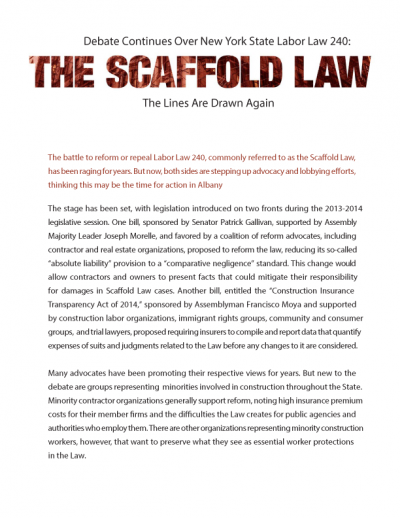
THE SCAFFOLD LAW
Page 7
WHAT ARE THE IMPLICATIONS FOR
WORKSITE AND WORKER SAFETY?
Labor representatives claim that reform would take away worker protections, particularly for minorities who make up a large percentage of construction workers. It seems reform certainly would eliminate what traditionally has been characterized as a no-fault benefit for workers.
Reform advocates argue that, currently, when the Scaffold Law is invoked, the only question to determine, through negotiation or litigation, is the amount of damages awarded. Of late, damage awards have, in the words of Felice Farber, Director of External Affairs for the General Contractors Association, "pierced the coverage umbrella," causing many insurance companies to back away from construction coverage and those that remain to increase their premiums dramatically.
Ms. Farber added that high awards for plaintiffs coupled with the expanding judicial definition of "heights" have increased premiums and reduced the number of willing carriers, precipitating the current crisis. "This is not about safety," she said, since safety protocols are not considered when seeking damages under the Law. BCTC agrees that worksite safety is consistently improving and injuries are down. All the more reason, the organization believes, for greater scrutiny of actual insurer costs and for skepticism about the drastic hikes in premiums.
But the problem - for insurers and their clients and the workers these clients employ - seems less to do with overall safety and more to do with the unchecked and unknown liability of Scaffold Law claims. Putting it succinctly, Mr. Elmendorf says reform will benefit all parties, adding that now, "The only people winning are lawyers."
Louis J. Coletti, President of the Building Trades Employers' Association, which represents contractor organizations, has been involved in reform efforts and safety programs for many years. He said, "All parties agree that the building industry has made tremendous progress on safety in the decades since the Scaffold Law was enacted. And study after study shows that the provisions in the Law no longer help to protect workers, but only protect those who want to exploit them and their employers." He added, "Now is a perfect time to update the Law so it can reflect current standards and practices, and help - rather than hinder - New York's economy."



